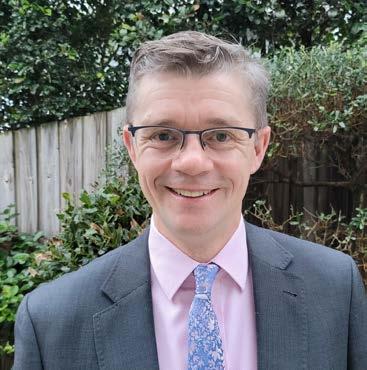
6 minute read
The Queensland Trauma Committee
“What is the mechanism for the injury? Is there anything that could be changed to reduce the rate of injury such as product design?” The Queensland Trauma Committee (QTC) is a longstanding sub-committee of the Royal Australasian College of Surgeons (RACS). It reports to the RACS Trauma Committee (bi-national) and the Queensland State Committee (QSC). QTC’s purpose is to contribute to injury prevention and related matters of public interest, and support surgeons in trauma care.
The Trauma Committee’s work is broad, including areas such as road trauma, alcohol-related trauma, falls in the elderly, and domestic violence. The areas of greatest significance are defined by the Trauma Committee. QTC’s membership is made up of senior representatives of the Queensland Statewide Trauma Clinical Network (STCN), the Jamieson Trauma Institute (JTI), the Queensland Audit of Surgical Mortality, Queensland Police and Ambulance Services, the judiciary, Queensland Retrieval Services, Royal Automobile Club of Queensland (RACQ), and a wide range of surgeons. Dr Matthew Hope (pictured, right) has been Chair of QTC since 2017. Based in Brisbane, he’s an orthopaedic surgeon who specialises in foot and ankle surgery. He also sits on the RACS Trauma Committee and the Australian Orthopaedic Association Executive Committee. Dr Hope says of his work with QTC: “It’s interesting and it takes you out of the sphere of clinical practice, in which we can all get tied up. I’m seeing many injuries in my work. What is the mechanism for the injury? Is there anything that could be changed to reduce the rate of injury such as product design?” Activities of QTC over the past 30 years have involved investigating blood alcohol levels associated with driving and working to mandate seat belts and child restraints.
Advertisement
More recently, QTC has reviewed quad bike injuries, with a focus on rollover prevention. In 2020, quad bikes were the most common cause of on-farm fatalities.
Over a 10-year period, QTC has been associated with changing safety regulations for quad bikes, in consultation with various organisations, including the Australian Competition and Consumer Commission (ACCC). In October 2021, legislation was finally passed requiring all new quad bikes to have rollover protection.
There are still many older quad bikes in circulation, but QTC is expecting to see a reduction in the number of injuries as more quad bikes with rollover protection come into use under the new legislation. E-scooters have also been a recent area of interest. Hire e-scooters were brought in by Brisbane City Council in late 2019. Hospitals saw a rapid increase in injuries as a result. Now, riders of faster, privately-owned e-scooters have been subjected to highenergy trauma. QTC has reviewed data collected by JTI on e-scooters and related injuries. This was taken to Brisbane City Council and the Department of Transport and Main Roads, along with several other key stakeholder groups. Recent e-scooter reforms now restrict the speed on footpaths to 12 km/hr and tougher fines will be implemented. Brisbane, Moreton Bay and Logan are three of the top four local government areas for motorcycle fatalities in the past 10 years. QTC, with JTI, has identified that lower limb and pelvic injuries are 26 times more likely to occur in a motorcyclist than a car occupant. Ongoing work will look at the financial burden of these significant injuries. The Foundation for Alcohol Research and Education (FARE) has spoken with QTC about collecting blood alcohol measures in emergency departments. QTC is currently working with JTI to explore the high frequency of alcohol-related trauma. QTC does not manage funds or collect data itself. The committee relies on the collaborative support of its members. QTC identifies preventable causes of trauma in Queensland and then works with a team like JTI to collect relevant data.
JTI aims to advance trauma prevention and research to deliver the best possible care for people who suffer a traumatic injury. They analyse data collected from existing health care data systems to better understand the causes, trends, patterns, burden, costs, and outcomes of trauma in Queensland. Professor Kirsten Vallmuur (pictured, left) is Chair of Trauma Surveillance and Data Analytics in a joint position between the Australian Centre for Health Services Innovation and JTI. “We monitor the numbers, types and causes of injuries coming through Queensland emergency departments and hospitals. We provide summary data to stakeholders around the patterns we’re seeing … times of day, days of the week, locations, severity of injury, and what the outcomes are for those patients.” E-scooter and electric personal mobility device (ePMD) injuries are primary examples of the types of data currently being collected. Any area where there is public debate about safety has the potential for analysis. The data JTI collects is key to providing evidence of the need to address a public safety issue. Having reliable data to back up safety recommendations is a driving force for change with regulatory groups. The main barrier to JTI’s work, Professor Vallmuur says, is time. Ethics and governance applications and site-specific agreements can take enormous amounts of time to complete before data can be collected. Professor Vallmuur says checks and balances are important but she hopes processes will be streamlined as digital health platforms become more commonplace, allowing more rapid approvals and access to data—enabling timely reporting of injury patterns and emerging trends. Currently, the whole process, from initial collaborative discussions to collecting data and forming recommendations that are eventually legislated, can take up to 10 years. “It’s not a quick process and you have to be patient. There’s lots of work in the background with consultation documents,” says Dr Hope. To achieve effective results in trauma prevention, Dr Hope says that knowledge and resources are shared between QTC, JTI and STCN through close collaboration. Defining the roles of each organisation has reduced duplication and improved the level of teamwork. Professor Vallmuur thinks the future of trauma care is exciting. By 2032, she predicts that we will have the technical capability and infrastructure to support apps installed in our vehicles, phones and wearable devices that are linked with emergency and trauma services. Data will be interpreted and shared more efficiently, enabling faster access to appropriate care.1 She also thinks that data on patient outcomes will improve in the future as technology improves; such data are not routinely captured from all patients. Professor Vallmuur says patients will have opportunities to be more engaged in contributing data (for example, quality of life, pain measures or mental health measures) in more automated ways— most likely via wearables and apps. On the horizon for QTC is work potentially reducing lawn mower injuries. Surgeons see adults and children who have sustained devastating hand and foot injuries requiring extensive reconstructive surgery. QTC will review data and consider if safety recommendations could be made for lawn mower design or use to reduce injuries. QTC has also reviewed data on child injuries from dog bites. Dog ownership has increased during the pandemic. Children aged three to five are most at risk from a dog known to them and will usually be injured in the head and neck area. These injuries may be reduced through education—potentially via antenatal classes, vet services, doctors’ surgeries, and groups advocating for child safety and the wellbeing of dogs. QTC will continue its collaborative work with many groups to reduce the incidence of trauma and improve public safety in Queensland.
Reference

The Future of Trauma Data is a vision for 2032: https://vimeo. com/692767731








